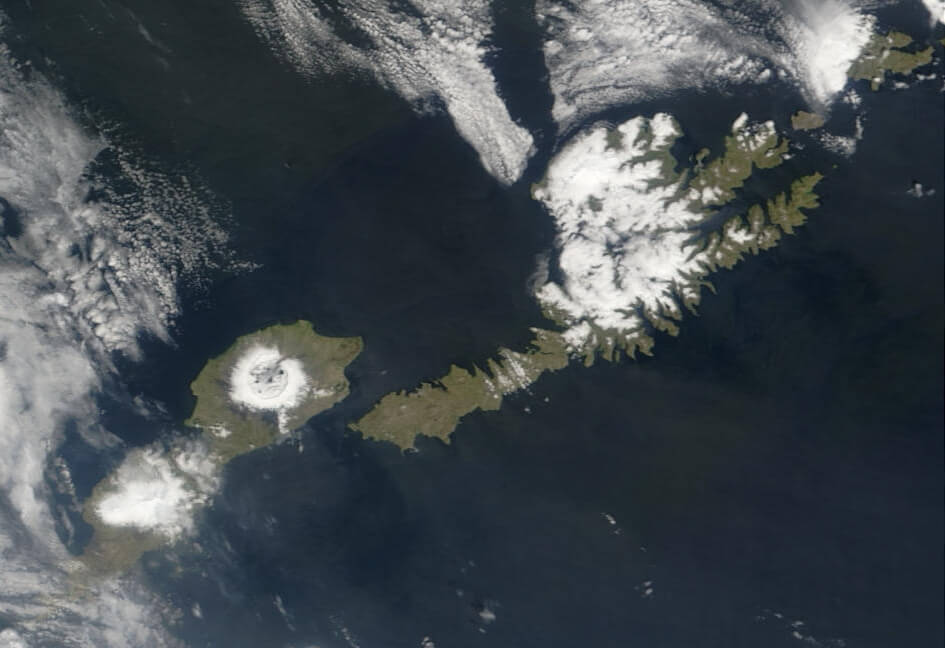How does the American island, which was once Russian
The climate of Unalaska Island is one of the harshest places on the planet. In the late 1700s, the Aleutian archipelago became a colony of the Russian Empire, and to this day many local residents have Russian surnames. There is also an Orthodox church here, but there are only about a dozen parishioners.
On the border with Asia
This American island is one of those that in the ridge of the Aleutian archipelago separates the North Pacific Ocean from the Bering Sea, says Air force. From the continental United States, it is further west than the Hawaiian Islands.
In fact, it is located in the transition zone - from North America to Siberia. The island's location—literally on the doorstep of East Asia—makes it one of Alaska's most remote and most distinctive areas.
Where the winds are born
Part of the Aleutian Islands, a volcanic archipelago that stretches 1100 miles westward in a huge crescent of ocean that ends just 600 miles from Russian Kamchatka, Unalaska is one of the harshest places on the planet, except perhaps in the polar regions. . Blown by a never-ending wind, the coastline, practically devoid of trees, looks harsh and inaccessible.
The Aleutian Islands are located in the so-called Pacific Fire Belt, subject to frequent earthquakes. Half of the local volcanoes 70, including the active Makushina volcano on Unalashka, have erupted over the past 250 years at least once.
“The Cradle of Storms” and “The Place Where the Winds Are Born” - these nicknames of the Aleutian Islands are absolutely deserved. Neighboring seas each create their own meteorological conditions, and the collision of these two systems constantly gives rise to cyclones, storms, hurricane-force winds, torrential rains and thick fog. All of this has a major impact on the weather in Canada and the continental United States.
9000-year-old culture that disappears
Nowadays, about 5 thousand people live in the city of Unalaska. The majority are employed in the fishing industry. A small percentage of the indigenous inhabitants, the Aleuts, remain among the population. These people have inhabited the Aleutian Islands for at least 9000 years, and their way of life reflects the characteristics of a harsh life - when they have to make the most of what little the local land and sea give to a person.
In recent centuries, the Aleut population has been steadily declining - both due to diseases brought from outside and due to the dying of the culture itself with the arrival of the “white man” to the islands. Today, there are only about 3 Aleuts left in all of Alaska and the Aleutian archipelago. Shayla Shaishnikoff, 800, and her 24-year-old brother Talon Shaishnikoff (pictured) are among the two hundred indigenous people still living on Unalaska Island.
Slice of Russia in the USA
After the Russian navigator, Danish by birth, Vitus Bering and his expedition assistant Alexei Chirikov became the first Europeans to visit the Aleutian Islands in 1741, a stream of Russian fur traders poured into the archipelago. They were attracted by the living wealth of the islands - sea otters and fur seals.
In the late 1700s, the islands became a colony of the Russian Empire. To this day, many of their inhabitants have Russian surnames. Following the fur traders, the Russian Orthodox Church came to the archipelago. Small churches were built on the islands, and many Aleuts converted to Christianity.
And after the United States bought Alaska along with the Aleutian Islands from Russia in 1867, the Orthodox legacy persisted.
The Church of the Ascension of the Lord in Unalaska (pictured) is one of the churches that has survived to this day. It was built in 1896 and is considered the oldest Christian place of worship in North America. It contains icons and interior details inherited from two previous churches that stood on this site at the beginning of the XNUMXth century.
"Honor and Responsibility"
Aleut Even Bereskin is the rector of the Church of the Ascension of the Lord and the only Orthodox priest of Unalaska. He was appointed rector in 2013 and now cares for the parishes of the islands of Unalaska, Nikolsky, Akutan, as well as two of the four Pribilof islands - St. Paul and St. George.
“I am constantly in awe that I am entrusted with the care of this stunning relic building,” he told me. “It’s an incredible honor and responsibility.”
Immediately after his appointment, Father Even began to raise money for the restoration of the temple and the restoration of icons affected by time and weather. To make the service more understandable to the parishioners, he began to serve the liturgy in English, refusing to use Aleut and Church Slavonic.
On the island, there are now more than 100 baptized into Orthodoxy, but only ten people attend weekly services.
Under attack
Before World War II, the United States had few commercial or military installations in the Aleutian Islands. Because the archipelago is relatively close to East Asia, there was a risk of attack on the islands - a risk especially acute after Japan bombed Pearl Harbor. Indeed, on June 3-4, 1942, aircraft from two Japanese aircraft carriers attacked Dutch Harbor (Dutch Harbor) in the city of Unalaska (on the northern coast of the island), resulting in the death of 50 people.
A few days later, the Japanese military landed on the islands of the Kiska and Attu archipelago (which are 670 and 850 miles from Unalaska, respectively), thus trying to exert psychological pressure on the United States and divert its forces from the theater of operations in the central Pacific Ocean, where the famous Battle of Midway was about to break out (the victory of the US fleet over the Japanese fleet in that major naval battle is considered a turning point in the war in the Pacific. - Translator's note).
The landing of the Japanese on the islands of the Aleutian Archipelago was for the United States the first foreign invasion of their territory after the British invasions of the 1812 of the year. The Northwestern ship (pictured), a passenger and cargo ship that the US Navy used during the war, was destroyed by a Japanese raid on Dutch Harbor. Its rusted hull still towers above the sea as a constant reminder of that bloody page of history.
Forgotten fights
Over the next few months after the attack on Dutch Harbor, 145 American and Canadian troops were stationed in the Aleutian archipelago to defend it and retake the islands captured by the Japanese. Artillery was placed here and fortifications were built, such as a bunker on a hill above Dutch Harbor (pictured).
A few miles from Unalaska, a large military base was erected on Mount Ballyhoo - Fort Schwatka, overlooking Unalaska Bay and controlling the approaches from the Bering Sea. Inside this coastal defense stronghold were about a hundred buildings, built to withstand earthquakes and hurricane-force winds.
The battles for the islands of Atta and Kysk were fierce and bloody, the victims were added by severe weather conditions. Thousands died on both sides of the conflict. By August, the Japanese were finally expelled from the Aleutian Islands by 1943, and the battles that were going on here were gradually forgotten.
Painful memories
Following the Japanese attacks, American military commanders ordered the evacuation of all local residents from the archipelago out of fear for their safety and to prepare the islands for the arrival of military forces. The islanders were given less than a day to get ready, allowing each person to take only one suitcase with their belongings - without telling them where they were being sent or when they would return.
About 900 Aleuts were taken out of nine villages from the entire archipelago and resettled for three years in abandoned canneries in the forests of southeastern Alaska, where the climate was temperate. Most Aleuts had never left their island before; many saw trees for the first time. About 10% exported died due to poor sanitation, terrible living conditions and lack of medical care.
Those who returned to Unalashka in 1945 found their houses looted or burned.
In 1980, the indigenous people (along with Japanese-Americans who also interned during the war) filed a lawsuit for ill-treatment and abuse of their rights. In 1988, a restitution law was passed, under which financial compensation was paid to the indigenous people of the Aleutian Islands, and apologies were made to the US President and Congress.
A stone stele (in the photo) was erected on Unalaska in memory of that tragedy of the war years.
Р> РѕРІРёСЃСЊ, СЂС <Р ± РєР °
After the Second World War, Unalashka became one of the centers of the American fishing and fish processing industry (this is still the main occupation of the inhabitants of the islands).
Dutch Harbor takes more fish caught than any other American port. Salmon, halibut, herring, several species of crab are caught in the waters of the archipelago.
Every year, four hundred vessels come from 14 countries, whose catch is about 10% of the catch of the entire American fishery industry.

Photo: MODIS Rapid Response Project at NASA / GSFC /Wikipedia, public domain
Where does the filet-o-fish at McDonald's come from?
Alaskan pollock makes up 80% of all seafood processed at Unalaska. From it, among other things, fish oil is obtained, fish fillets (for McDonald's sandwiches) and surimi (imitation crab meat) are made.
The island's largest fish processing plant, UniSea, adheres to the strictest environmental standards, including effective product traceability and keeping bycatch as low as possible.
“We use literally every part of the pollock, and nothing goes to waste,” says Tom Enlow, president and CEO of UniSea and an Unalaska resident. — Fish oil is a renewable source of hydrocarbons that help heat the premises of the plant and the homes of our employees. This way we minimize the use of diesel fuel.”
Marine life in all its abundance
In addition to an abundance of all kinds of fish, Unalaska boasts a large concentration of marine mammals - one of the most significant in the world. It is home to killer whales, porpoises, sea otters, seals and whales (humpback whales, pilot whales and fin whales).
During the breeding season, from May to July, the local sea lions (the largest of the eared seal family) set up rookeries on remote stone reefs and rocky islets of Unalaska (pictured).
The Aleutian Coast is home to many seabirds, more numerous here than in the rest of the United States. Bird watchers come here from all over the world to look at the local waterfowl, especially in the hope of seeing such a very rare bird as the little auklet.
Nature trails
If the weather permits, try to walk through the protected parts of the island of Unalaska. Expanded alpine meadows and picturesque mountain peaks offer you the soul of the Aleutian archipelago.
Poetic landscapes at least slightly soften the cruelty and sometimes even the ruthlessness of the natural conditions of these places.
Read also on ForumDaily:
9 places in America where you need to visit at least once in your life
This year, the US area has increased: how it happened
7 locations in North America that resemble Europe
Subscribe to ForumDaily on Google NewsDo you want more important and interesting news about life in the USA and immigration to America? — support us donate! Also subscribe to our page Facebook. Select the “Priority in display” option and read us first. Also, don't forget to subscribe to our РєР ° РЅР ° Р »РІ Telegram and Instagram- there is a lot of interesting things there. And join thousands of readers ForumDaily New York — there you will find a lot of interesting and positive information about life in the metropolis.











